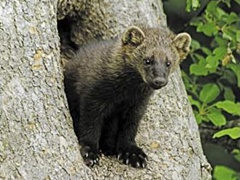
Welcome to Hemlock and Canadice Lakes!
Barns Businesses Cemeteries Churches Clinton & Sullivan Columns Communities Documents Events Time Line Fairs & Festivals Farm & Garden Hiking Homesteads Lake Cottages Lake Scenes Landscapes Library News Articles Old Maps Old Roads & Bridges Organizations People Photo Gallery Podcasts Railroad Reservoir Schools State Forest Veterans Videos
|
“Nature in the Little Finger Lakes” by Angela Cannon Crothers |
|
|
The Fisher - Wildlife Legend Angela Cannon-Crothers February 2017 A fresh stage of snow is honest. Secret lives surrounding us are suddenly cast. There is a phantom in the woods. I see signs of him everywhere. His tracks are rather large - 2½ inches across - made by his five-toed feet with retractable crescent claws. I find his tracks bounding through the hemlock glens and meandering across the top of Bristol Mountain. Still, this animal, said to be active both night and day, eludes me. I saw one once in the Adirondacks while working as a cloud collector on Whiteface Mountain. My brain registered large black cat, before my mind’s cataloging process scrolled down to fisher, one of the largest members of the weasel family. A return comer, having once been extirpated from New York State, there are now trapping seasons in some areas of even the central and southern tier regions. When I hear of local cougar sightings, I often think of how fisher might appear like that from a distance - a black panther of sorts. The Anishanabe and Algonquin called fisher, Gitchi Odjig, Great Fisher. He was considered an adopted brother to the in-between god and hero known as Nanabozo. Great Fisher was known for his bravery and magical powers, but mostly as the one who released the birds of summer in Skyland so that we would not have endless winter, but four seasons instead. For this brave contribution, Great Spirit hung the fisher in the night sky in what we know as The Great Dipper, or Ursa Major. I never could see the bear in that arrangement of stars; the long handle makes more sense as the long fluffy tail of a fisher. Maybe I spend too much time looking down instead of up. A female fisher will den up in the tree tops to raise her nest of two to three kits. She can also turn her hind feet nearly 180 degrees so that coming down a trunk is conducted as easily as a squirrel might do. The resilient fisher is an opportunistic feeder who eats an omnivorous selection of acorns, beechnuts, berries, and apples along with rabbits, squirrels, grouse, mice, shrews, and carrion. A deer carcass is a feast that a fisher will take up residence near until there are only bones and hair left to pick from its teeth. But it is the fierceness of fishers that stands out most. Fishers are the only hunters of porcupines, attacking from the front until the quilled animal is weakened, or knocking them out of the tree tops, wasting nothing but a hide of quills in the end. Last year my friend had two fishers in his backyard, raising quite the cat-style ruckus, so much so that at first he thought they might have been cats. Six years ago, two teens in Naples were surprised to find a fisher in their trap along Naples Creek, close to the village. The animal was released from the leg hold, and reported. I can only imagine how brave the children must have been as well, to be so close to an animal with all sharp teeth and snarls, driven by an endless will to hunt, and not easily seen. What it is like to find an animal you weren’t looking for, and didn’t know was even a resident in the area? As our forest ecosystems in the Finger Lakes continue to regenerate and mature, so, too, do the hidden habitats they provided; but species that make a comeback must still adapt to things not quite as they once were—fragmented woods, climate change, and human activity. That animals like black bears, bald eagles, and fishers can once again reside here is a testament to environmental recovery, but these and other species will need to continue to adapt to our changing world. I will keep eyes on their tracks, searching for a glimpse of the fierce and legendary fishers who probably know my whereabouts more than I do theirs.
|
||
|
Editor’s Note: Angela Cannon Crothers is a naturalist and writer who teaches at Finger Lakes Community College and with The Finger Lakes Museum. Here are some columns that she has written about the Little Finger Lakes. Her columns also appear in the Lake Country Weekender newspaper.
|
||
